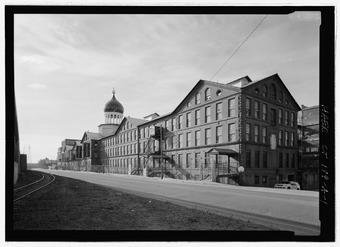Colt Armory facts for kids
|
Colt Industrial District
|
|
|
U.S. National Historic Landmark District
Contributing Property |
|

The East Armory Building
|
|
| Location | Roughly bounded by Wawarme, Wethersfield, Hendricxsen, Van Dyke Aves., and Stonington, Masseek, and Sequassen Sts., Hartford, Connecticut |
|---|---|
| Area | 130 acres (53 ha) |
| Built | 1855 |
| Part of | Coltsville Historic District (ID66000802) |
| NRHP reference No. | 76001987 |
Quick facts for kids Significant dates |
|
| Added to NRHP | June 8, 1976 |
| Designated NHLDCP | July 22, 2008 |
The Colt Armory is a very old factory where Samuel Colt made firearms. It is in Hartford, Connecticut, right by the Connecticut River. Since 2008, it has been part of the Coltsville Historic District. This area is so important that it was named a National Historic Landmark. Soon, it will become part of the Coltsville National Historical Park, which the National Park Service is planning.
History of the Colt Armory
The factory was built on a 260-acre (110 ha) piece of land starting in 1855. This land used to be wet meadows that often flooded. To fix this, a 2-mile (3.2 km) wall, called a dike, was built to keep the river out. The land was then drained.
The dike and the first factory buildings were finished in 1855. Samuel Colt's big house, Armsmear, was built the next year on a hill looking over the factory.
Soon after, Colt built 20 houses for his skilled workers. Each house could hold six to eight families. Ten of these original houses are still standing today.
The first East Armory building, built in 1855, was almost completely destroyed by a huge fire in 1864. Only two small buildings from that time, the Forge and the Foundry, are left. The West Armory, built in 1861, was taken down before World War II.
After the 1864 fire, the East Armory was rebuilt in 1867. It was designed by General William B. Franklin, who used to be an engineer for the U.S. Army and was then the company's general manager. The new building is made of brick with brownstone details. It is five stories tall and very long. Its main entrance sticks out from the front.
The building has a special onion-shaped dome on top. It is painted dark blue with gold stars, just like the dome on the first factory. A shiny gold ball sits on top of the dome. Above that is a gold-colored statue of the "Rampant Colt," which is a horse standing on its back legs. The original wooden statue is now at the Museum of Connecticut History.
Inside the factory, four large steam engines powered the machines. They used many shafts and belts to make everything work. Mark Twain, a famous writer who lived nearby, visited the factory in 1868. He said it had "a great range of tall brick buildings." He described the inside as a "dense wilderness of strange iron machines." He thought it took amazing minds to invent all those machines.
Today, the factory area still includes:
- The Forge Shop and the Foundry, which are from the very first factory built in 1855.
- The East Armory, with its unique blue onion dome, rebuilt in 1867.
- The South and North Armories, built in 1921.
- The Machine Shop, Warehouse, Power Plant, and Garage, built in 1916 for World War I production.
- The World War II Office Building, built in 1942.
The state of Connecticut has been working to have the factory complex managed by the National Park Service. They want it to become a National Historical Park. This would be similar to the Lowell National Historical Park, which is another important place in American industrialism history.
In 1994, Colt's Manufacturing Company moved out of the Hartford factory. They moved their operations to a newer location in West Hartford, Connecticut. A company called U.S. Fire Arms Manufacturing Company used to rent space in the East Armory. They first made copies of old Colt pistols. Later, they started making other things and stopped making the pistol copies.
Colt's Armory Printing Press
Besides making firearms, the Colt factory also made other items for different companies. One of the most famous was a letterpress printing machine called the Universal. This machine was designed by Merrit Gally.
From 1873 to 1902, the factory made many of these printing presses. They became known as some of the best hand-fed printing presses ever made. People still think they are excellent today. These presses were often called "Colt's Armory" presses. However, they were sold under different names like Colt's Armory, Universal, Victoria, Hartford, National, and Laureate.
Images for kids







